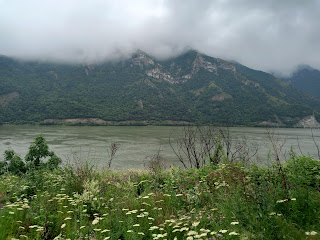As I cycled the undulating, good quality road, I would often pass signs highlighting the danger of rockfalls. I thought nothing much of them at first but it soon became obvious that these were not empty warnings: I regularly saw stones the size of a fist lying in the road, sometimes pieces the size of a head, and on one occasion as I pulled across the road into a gap in the foliage in order to take a photograph, I heard a rumble and thud as a piece of rock the diameter of a bicycle wheel slid down under the safety netting and tumbled onto the section of road I had just left.
Another thing that struck me was the number of roadside shrines. It was a little disconcerting as the road had seemed relatively safe to me: there was not much traffic and the long straight stretches gave ample opportunity for me to be seen. But now the shrines focused my mind on the road's more negative aspects: vehicles would pass at speed, there was no hard shoulder and for the most part very few opportunities to get off the road at all. There were also a number of unlit tunnels, mostly very short, but some were two or three hundred yards long and not straight so even lit up like a Christmas tree I felt very vulnerable pedalling through their length.
After twenty-five miles I had passed the first two gorges although the road had not offered good views and there was nowhere to pull over to seek them out. The tunnels of course did not help so I mostly saw the wide river and its surrounding hills, cloud clinging to the tops, but no awe-inspiring cliffs and narrow gorges. However the twenty-five mile point did bring me to the Lepenski vir archeological site which I wanted to visit.
Prior to the completion of the Derdap I dam a number of archeological digs were carried out on the valley floor before it was lost underwater. One dig uncovered Lepenski vir, an ancient village dating from between 7000bc and 5000bc and one of the oldest urban sites in Europe. The inhabitants lived in tent shaped structures with sandstone floors, arranged around a central square, but the most significant finds were sculptures and carved figures, some of the first art. So significant was the site that the decision was made to move it above the new waterline where it now sits, exactly as it was, under a huge protective canopy. Seeing old footage of the dig on farmland that is now a hundred feet underwater was fascinating, as was seeing the remains of the settlement, but what really struck me were the highly decorated carved artefacts, roughly three millennia older than the stones at Stonehenge.
 |
| Sandstone 'flooring' |
On leaving Lepenski vir the weather had improved a little and I cycled to the next gorge, Veliki Kazan, with visible patches of blue pushing through a still-grey sky. This gorge was easier to see and very impressive with its sheer, grey cliffs constraining the river; it is the narrowest of the four gorges. A steady uphill climb took me to a viewpoint high above the river where I could look back to the gorge and also across to a massive rock carving on the opposite cliff. It represents Decebalus Rex, the last king of the Kingdom of Dacia in what is now largely modern day Romania. He fought against the Romans to retain his country’s independence but was eventually defeated by the Emperor Trajan. It is a colossal carving - the biggest rock relief in Europe - at nearly two hundred feet tall and it took ten years to complete. Apparently the businessman who commissioned it wanted a similar relief of a Roman emperor on the cliffs on the Serbian side, as if confronting Decebalus. The Serbs refused.
 |
| Decebalus on the right |
Within an hour I was back down at river level in the tiny waterfront village of Tekija where I am spending the night. I sat with my host on a small balcony with a view to the river and we shared a slivovitz before the tawdry business of handing over money (very Serbian I thought). This evening I need to try and use my remaining Serbian Dinar as tomorrow morning I enter Romania and I understand that changing them into Romanian Leu isn’t that easy. Given the village restaurant is shut today it looks like I will be doing that in the village shop.










No comments:
Post a Comment